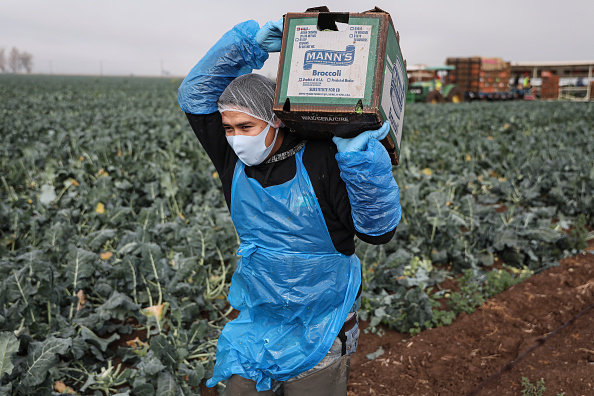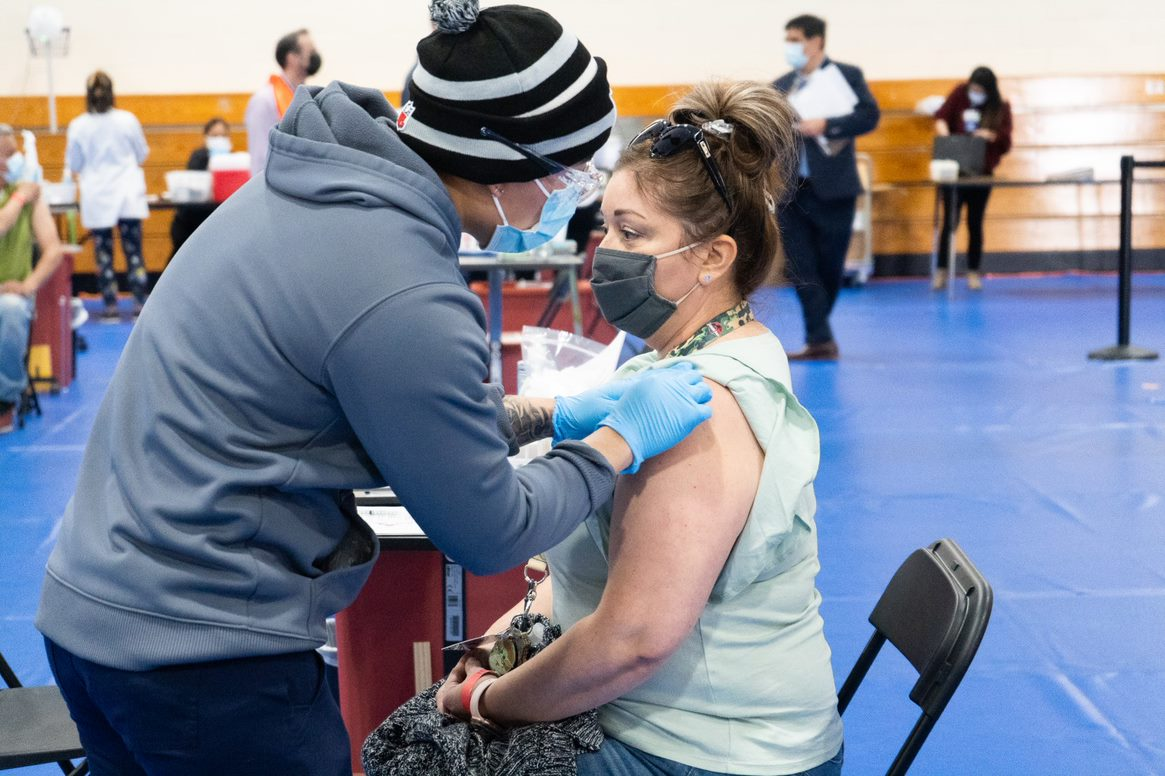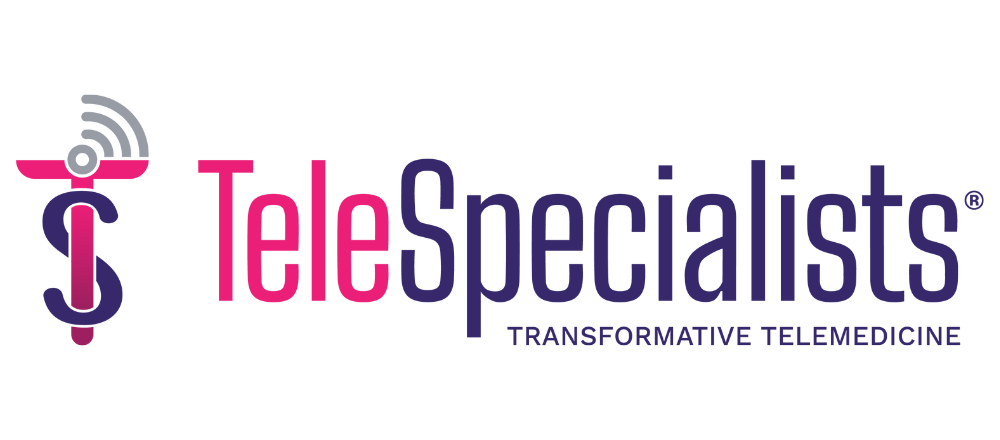
A farmworker carries a box of broccoli in a field in Calexico, California. Photo credit: Sandy Huffaker, Getty Images
At the beginning of the month, Imperial County Public Health Director Janette Angulo got some much-needed good news. She found out that the county would be getting a fresh shipment of vaccines – 8,510 doses – from the state. It would help the Southern California county vaccinate more essential workers, including farmworkers who grow much of the broccoli, carrots, lettuce and other winter vegetables eaten across the U.S.
California recently changed its vaccine allocation to send more doses to counties, like Imperial, that have been hit hardest by the pandemic. But in the weeks prior, supplies had been falling short. It is still very much a story of vaccine inequity in the nation’s most populous state and a nationwide phenomenon.

What Are Healthcare Organizations Getting Wrong about Email Security?
A new report by Paubox calls for healthcare IT leaders to dispose of outdated assumptions about email security and address the challenges of evolving cybersecurity threats.
“There were weeks where we would get a single box of Pfizer vaccine or Moderna vaccine,” Angulo said during a March 11 call with reporters.
Imperial County Commissioners sent a letter in February to Governor Gavin Newsom asking why the county had received so few doses, according to inewsource.
“‘Equity’ was and has been a theme that has resonated in your messages in regard to Covid-19 response efforts, yet we ask, where is the equity in the vaccine allocation distribution to counties,” they wrote.
This month, the county started rolling out travel clinics to bring vaccines to Salton City, Westmorland, Ocotillo, and other more remote areas where people might not have access to a clinic.
To date, Imperial County, which has more than 181,000 residents, has vaccinated fewer people than other, similarly-sized counties. As of March 19, it has administered a little over 47,000 doses, less than El Dorado and Napa counties, according to state data. As of March 11, it had received just under 44,000 total doses from the state, Angulo said.
The inequities become even clearer considering the pandemic’s effect. Imperial County has reported more than six times as many deaths from Covid-19 as El Dorado County, which has 193,000 residents, but a poverty rate that is less than half of Imperial’s. About 85% of Imperial County’s residents are Latino, and 22% of its residents have incomes below poverty, according to Census data.
Looking at the numbers, California is still falling far short of its goal of an equitable vaccine rollout. Although 40% of the state’s population is Latino, they only account for 21% of people that have been vaccinated so far.
A big gap in access
California’s vaccine troubles are not isolated. Three months into the pandemic, the U.S. is still grappling with glaring inequities in vaccine distribution. According to the latest data from the Centers for Disease Control and Prevention, a disproportionate number of the 77 million who have received their first vaccine dose are white. Meanwhile, only 9% of those who received vaccines were Latino, 8% were Black and 5% were Asian, less than their proportion of the U.S. population.
“It did paint a pretty consistent picture across states that showed a mismatch between who is receiving a vaccine and who is hardest hit by the pandemic,” said Samantha Artiga, Director of the Kaiser Family Foundation’s (KFF) Racial Equity and Health Policy Program. “The pattern does raise some early warnings.”
In Colorado, only 8% of people vaccinated are Latino, despite making up 22% of the state’s residents. Meanwhile, 73% of people who have received at least one dose are white.
Although state officials tried to attribute the gap to the fact that healthcare workers were vaccinated first, it still doesn’t explain the extent of the disparity. According to KFF data, less than half of people working in long-term care facilities are white, and just 61% of front-line hospital workers are white.
In Washington D.C., where residents battled a buggy vaccination website, 31% of people who have received the vaccine are Black – significantly less than the 46% of the city that they represent.
There are also significant gaps in what we know about who is getting the vaccine. According to the CDC, a little over half of the vaccination data is missing race and ethnicity information, and the available information doesn’t provide much insight on why the disparities are so pronounced.
A big factor is access, KFF’s Artiga said, as local governments still grapple with getting enough doses.
“Vaccine supply is limited and demand has exceeded supply,” Artiga said. “Vaccine access is on a first-come first-served basis. That type of process will make it harder for people who have more limited resources — not having access to the internet, a car for transportation — to be able to get a vaccine.”
Mixed messages about who is eligible for vaccines, and appointment scheduling systems that rely on people logging in through a web portal can also serve as barriers.
To address this, Artiga said communities should stand up vaccination clinics and prioritize appointments in areas that have been hardest hit by the pandemic. It’s also important to have scheduling options that aren’t reliant on internet access and to provide clear information about the vaccine through trusted community members.

Healthcare workers administer vaccines at Emmanuel Baptist Church in East San Jose. Photo credit: County of Santa Clara
Bringing vaccines to the community
In East San Jose, Santa Clara County is trying to accomplish that through a partnership with Emmanuel Baptist Church. Over the past several months, the church has served as a testing site, and now hosts vaccinations. During one week, they vaccinated 4,000 people, Pastor Jason Reynolds said in a Zoom interview.
It’s one of six mass vaccination sites across the county, and location was an important factor in the decision. The 50-year old church is in a zip code where nearly a tenth of its residents have gotten Covid-19, according to county data. And it’s a long distance away from San Jose’s biggest vaccination site at Levi’s Stadium, which would take nearly an hour to reach via transit.
“The fact that we’re doing it does add a level of credibility. People trust our church, they trust me as a leader, and they trust our leadership team,” he said. “We even got letters from some of our community members who said the fact that you had a vaccination site that was this close to my parents, my uncle or my auntie is the thing that allowed them to get it.”
After a year of holding church services virtually, Reynolds also hopes that the vaccines will bring everyone one step closer to being able to gather in person. As more community members get vaccinated, he’s hearing stories of people seeing their grandchildren for the first time.
“It really is hard, especially in these moments, the things we would normally do together. We’ve lost a number of members to Covid,” Reynolds said. “How do you support those families from a distance?”
In Arizona, communities that struggled to get enough tests early in the pandemic are now facing a similar problem with vaccines. While the state has opened a handful of mass-vaccination sites, none of them are in the hardest-hit zip codes.
“They put up these large POD sites. But they were far away from the communities that had been hit the hardest,” Equality Health Foundation Interim CEO Tomás León said. “That created an immediate barrier. There was no bilingual registration site.”
Over the summer, the Equality Health Foundation opened a testing site in the neighborhood, where there hadn’t been any. They were quickly overwhelmed by demand, with lines running up to 13 hours long.
Now, in Phoenix’s Maryvale neighborhood, the nonprofit is working with a local church, the city of Phoenix and Walgreens to offer vaccines, food, and other resources.
“People are dying. We’re in a public health crisis still. We need to respond quickly to needs of community,” León said.

Dr. Beth Harp, a physician and a citizen of the Cherokee Nation, receives her first dose of the Covid-19 vaccine. Photo credit: Cherokee Nation
A success story
Although many communities have struggled with getting vaccines into people’s arms, the Cherokee Nation’s vaccine rollout has been held up as an example of success.
As of last week, the Cherokee Nation had vaccinated 36,000 people. It currently has about 141,000 citizens living within its borders, and more than 240,000 across the state of Oklahoma. Now, it is opening vaccine appointments to anyone who wants them.
Initially, government leaders prioritized healthcare workers and first-language speakers, the roughly 2,000 people who still speak Cherokee fluently. They worked with the Cherokee Nation’s language and culture department to contact first-language speakers in the early phases of the vaccine rollout.
“It was impactful to our healthcare workers. We were bringing in medical students, nursing students and staff… to be able to meet those people, to be able to interact with them, to be able to hear them interact with each other speaking the language,” Cherokee Nation Health Services Executive Director Dr. R Stephen Jones said in a phone interview.
They were able to quickly move through subsequent tiers, calling people or helping them schedule appointments through their patient portal. But now, the hardest work comes next – bringing vaccines to people in remote places and opening them up to people who aren’t part of the health system.
Part of the challenge is just simple logistics. While in a facility, it’s easier to calculate how many doses are needed based on scheduled appointments, it gets more challenging bringing out thawed vials for a community outreach event.
Public health workers are also conducting surveys and talking to local leaders to figure out what vaccine hesitancy is in the community, so they can prepare and try to overcome those obstacles before bringing in vaccines.
“Each time you open another phase, you get a really good response of those that have been waiting for next phase to open up. Then it tails off,” Jones said. “We want to make sure we are good stewards with the allocations we’ve been given.”








